Is Beef Ribs Good for You
Carnivores are virtually united in their love of ribs. If I weren't already convinced this opinion was correct, it was cemented when I did a search on, "Why do people like ribs?"
This led me to an article eye-catchingly titled (in full caps), "YOU'RE STUPID IF YOU DON'T LIKE RIBS!" The only support for this assertion is a parade of food porn shots of different kinds of ribs.
Of course, I agree, though I may not have expressed it quite the same way.
But, it's a simple truth that ribs are delicious, and they're fun to eat. You can dress them up so many ways, cook them in almost anything — in short, you never have to have the same rib experience twice. But, which ribs should you start with?
Today we're comparing beef ribs vs. pork ribs to learn the differences and the similarities. You'll learn the various rib cuts, nutritional and pricing information, and how to cook them. Plus, we'll share three of the best recipes on the internet for beef ribs and three more for pork ribs.
Keep reading for the full rib-stravaganza!
Contents (Jump to Topic)
- 1 Difference in Taste Between Beef Ribs and Pork Ribs
- 2 Size Comparison
- 3 Pork Rib Cuts
- 3.1 Baby Back Ribs
- 3.2 Spare Ribs
- 3.3 St. Louis Style Ribs
- 3.4 Rib Tips
- 3.5 Country Style Ribs
- 4 Where to Buy Pork Ribs Online
- 4.1 Snake River Farms
- 4.2 Porter Road
- 5 Beef Rib Cuts
- 5.1 Plate Short Ribs
- 5.2 Chuck Short Ribs
- 5.3 Beef Back Ribs
- 6 Where to Buy Beef Ribs Online
- 6.1 Porter Road
- 6.2 Snake River Farms
- 7 Fat to Meat Ratio and Fat Content
- 7.1 Pork Ribs
- 7.2 Beef Ribs
- 8 Pork Ribs (Spare Ribs) Nutritional Info Per 4oz (¼ Pound)
- 9 Beef Ribs (Short Ribs) Nutritional Info Per 4oz (¼ Pound)
- 10 Price Comparison
- 11 How to Cook Pork Ribs
- 12 How to Cook Beef Ribs
- 13 3 Excellent Pork Rib Recipes from Around the Web
- 13.1 Smoked Dr. Pepper Ribs
- 13.2 Competition Style Smoked Pork Ribs
- 13.3 Indian-Spiced Ribs
- 14 3 Excellent Beef Rib Recipes from Around the Web
- 14.1 Smoked Cola Coffee Beef Ribs
- 14.2 Texas-Style Beef Short Ribs
- 14.3 Dinosaur Ribs (Pineapple-Marinated Smoked Beef Ribs)
- 15 Final Thoughts
Difference in Taste Between Beef Ribs and Pork Ribs
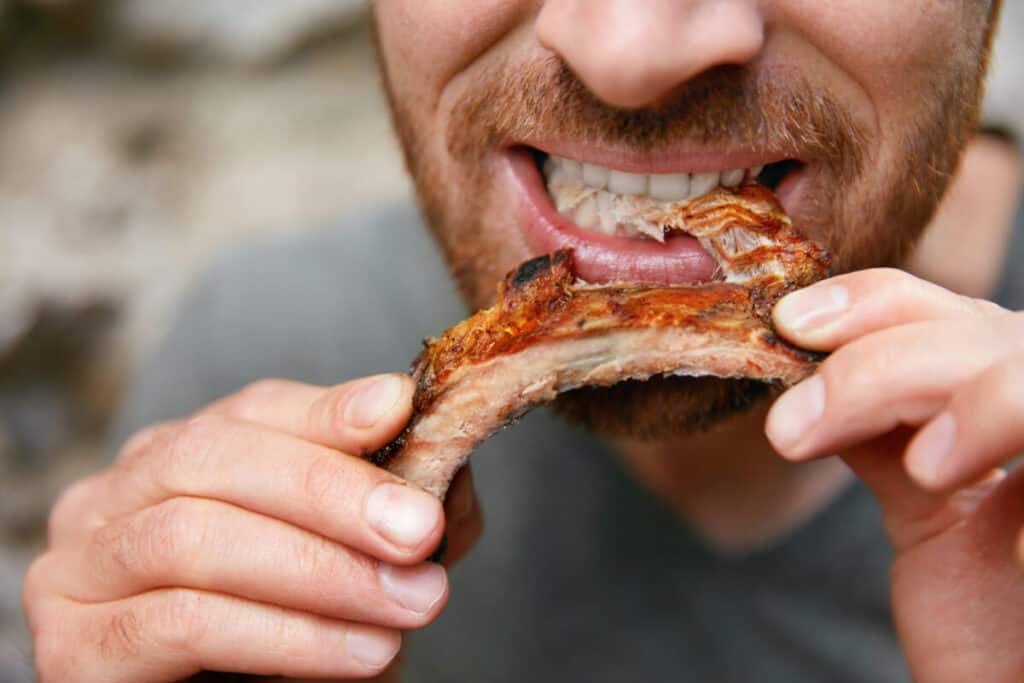
Describing flavors is never easy, but here goes.
Beef ribs have a very strong flavor, as all good cuts of beef do. It's distinct and unmistakable — but what is it?
I suppose you could call it "beefy," but that breaks the old rule of never using a word in its own definition. A better word for beef flavor is "umami." If you haven't heard it before, that's not a big surprise.
Umami is the fifth taste our tongues can detect, along with sweet, sour, salty, and bitter. Proteins release the deep rich flavor that is umami, and you find it in mushrooms, carrots, seaweed, bacon, and more. If you want to learn more about umami and beef, this article in Beef Magazine is a great place to start.
On the other hand, pork ribs have a much tamer flavor than beef, which you might describe as oddly sweet. On their own, they taste a lot like pork chops — mildly pleasant. But, that's why chefs, pitmasters, and backyard barbecuers love them; they're a blank canvas for painting on any combination of spices, seasonings, and sauces you care to try.
Size Comparison
Did you ever go to a farm and see a pig standing near a cow? Can you at least imagine them side-by-side? Then you can already guess that beef ribs are almost always bigger than pork ribs.
Beef ribs can be so huge that they're sometimes sold under the name "dinosaur ribs." (Hands up if you're picturing Fred Flintstone at the drive-in restaurant!) Depending on the cut, a single rib might be 8 to a whopping 12 inches long and weigh 2 pounds or more.
Pork ribs are considerably smaller, with portions measured in ounces, with bones not more than a few inches long. However, because of the way butchers trim them, a rack of pork ribs may not be that much smaller than a rack of beef ribs before they're packed and shipped to the grocer.
Pork Rib Cuts
Like other sections of the pig, the butcher divides the ribs into various cuts, creating a few different types of pork ribs.
Each cut has its own "personality" if you will. Here's a rundown of each pork rib cut and a few details about each.
Baby Back Ribs
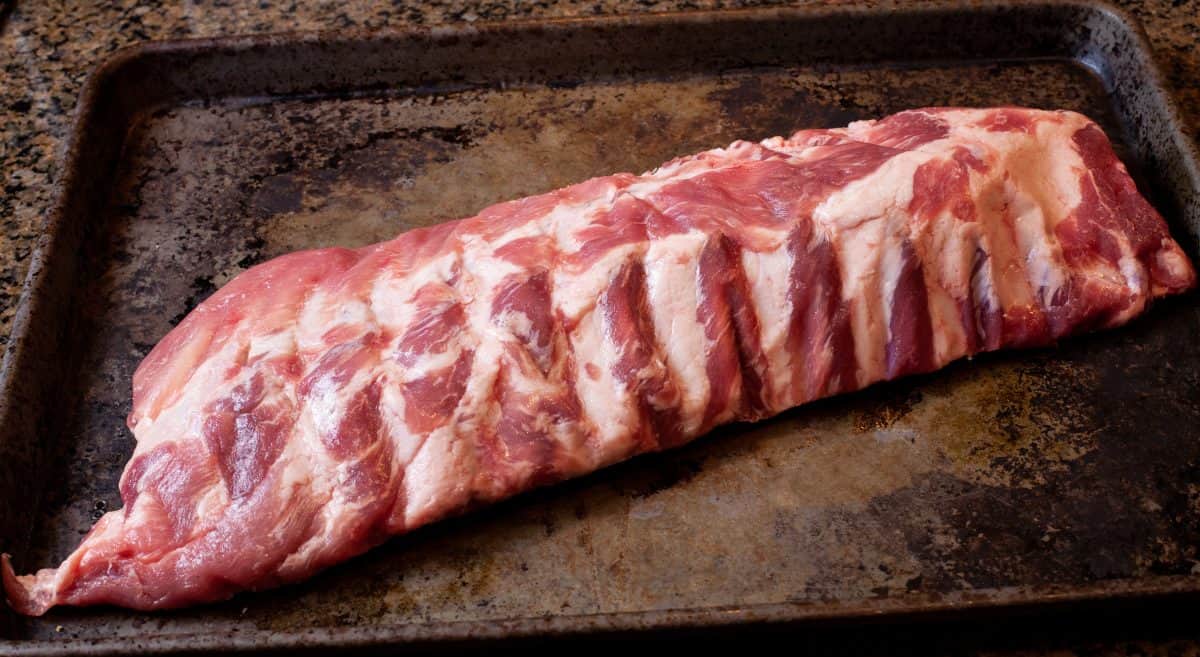
Cut from the highest point on the rib cage, baby backs are lean and tender. They aren't as meaty as other pork ribs, though, but their convenient size and shorter cooking time make them popular at restaurants.
You may see them labeled as "loin ribs" or simply "back ribs."
Spare Ribs
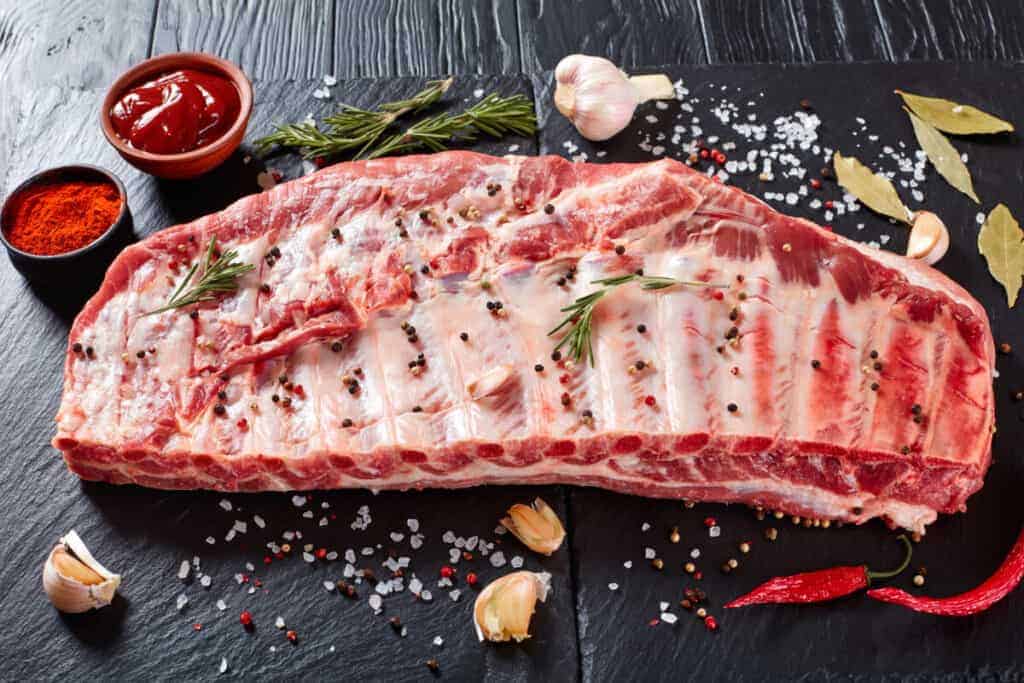
Wildly popular, spare ribs (sometimes shortened to 'spareribs') begin where the baby back ribs end. They extend down the side of the pig right to the breastbone. They don't have the curve baby backs have, but they do have a fair bit more meat.
They're typically less tender but more flavorful than baby back ribs. Other names include "side ribs" and plain old "spares."
St. Louis Style Ribs
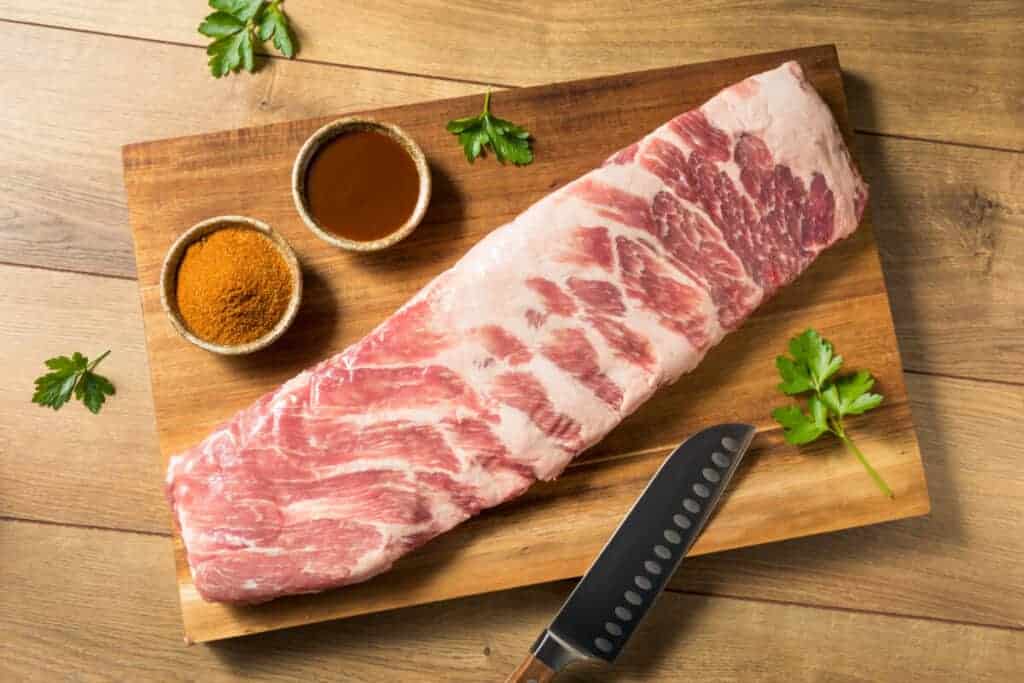
A tidy, mid-size rack, St. Louis ribs are cut from the spare ribs. The butcher removes the cartilage and small bits of bone from the ends of the spares and squares off the sides. The result is a flat, rectangular rack of good meat that cooks evenly and looks terrific on a platter.
They aren't easy to find, though, so you may have to make your own.
Rib Tips
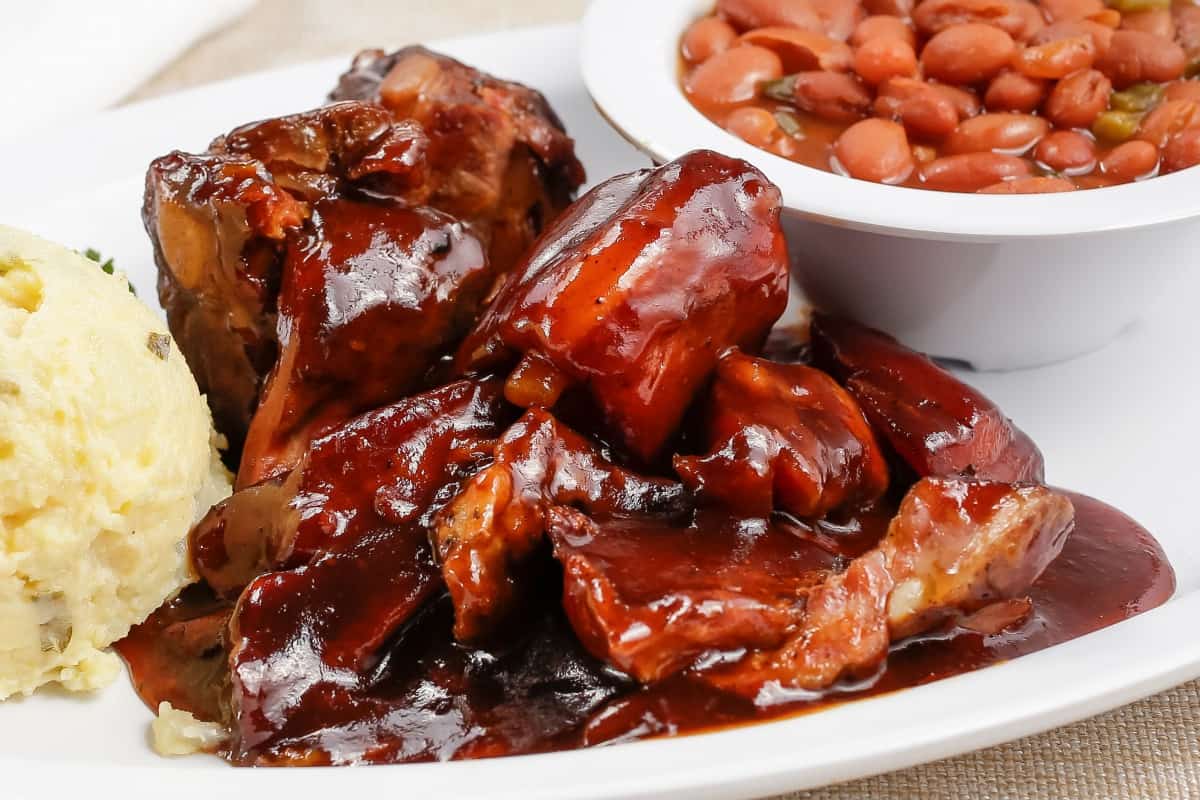
Those ends that got cut off to turn spare ribs into St. Louis ribs? That's the rib tips. They're very tender, with a lot of fat marbling.
Rib tips aren't easy to eat since the fat-to-meat ratio favors the fat. But, they're very tasty and a lot of fun to pick up and nibble on.
Country Style Ribs
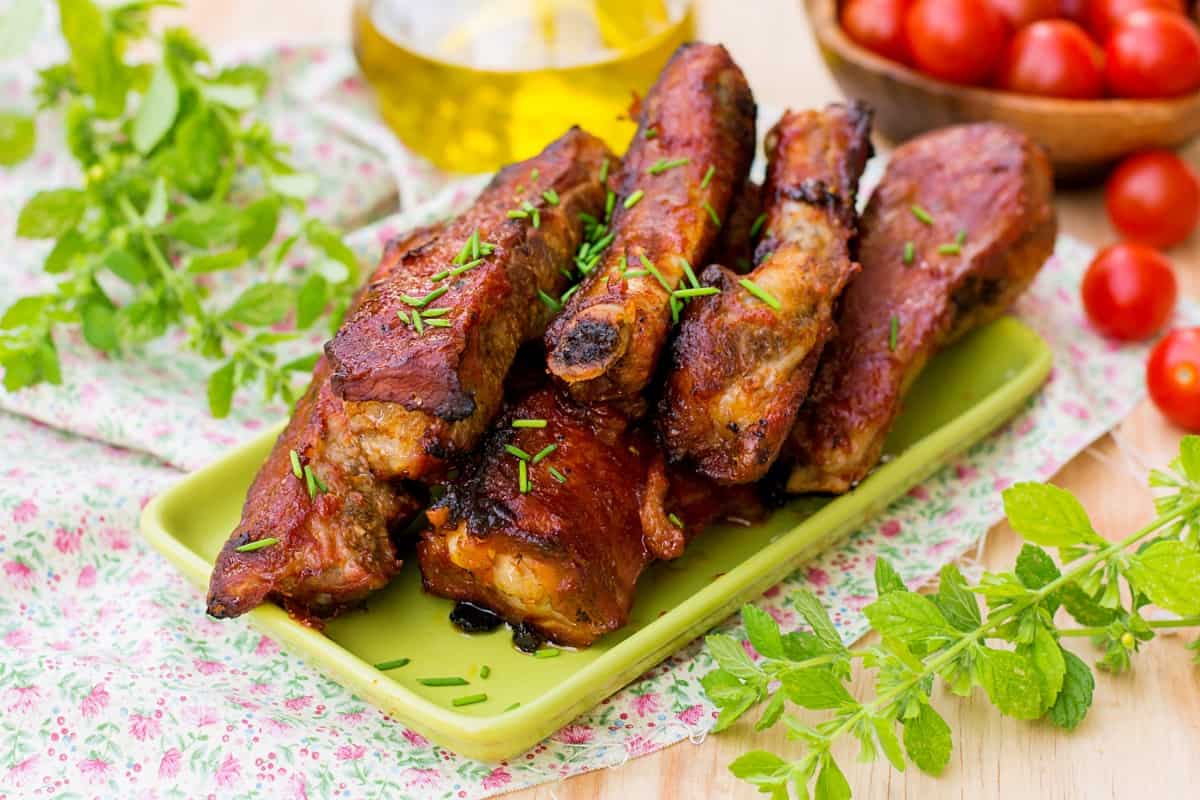
It's a bit of a stretch to call these "ribs" but, we'll cover them anyway. A better description would be "bone-in pork chop," and depending on the cut, it may be one or two bones.
The meat is loin meat, so it's tender and delicious. Yes, I'm trashing the name a bit, but the cut itself is a treat.
Where to Buy Pork Ribs Online
Pork ribs are sold by the vast majority of online outlets, making them easy to source, and affordable due to the amount of competition.
Here are a couple of suppliers that we highly recommend:
Snake River Farms
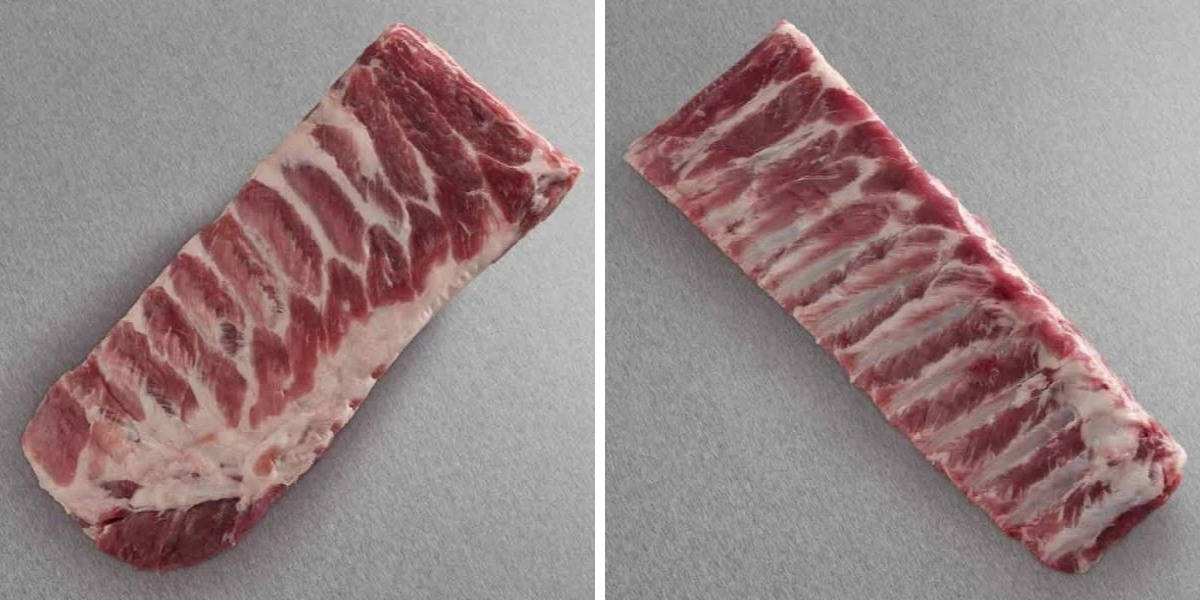
Snake River Farms spare ribs are a full-sized rack weighing on average 1.5 lbs. They are 100% purebred Berkshire Kurobuta pork, raised naturally with no added hormones, providing generous amounts of meat and flavorful marbling.
They also sell baby back ribs of the same quality, from the same purebred species, that come in at an average weight of 1lb per rack.
Check Price on Snake River Farms
Porter Road
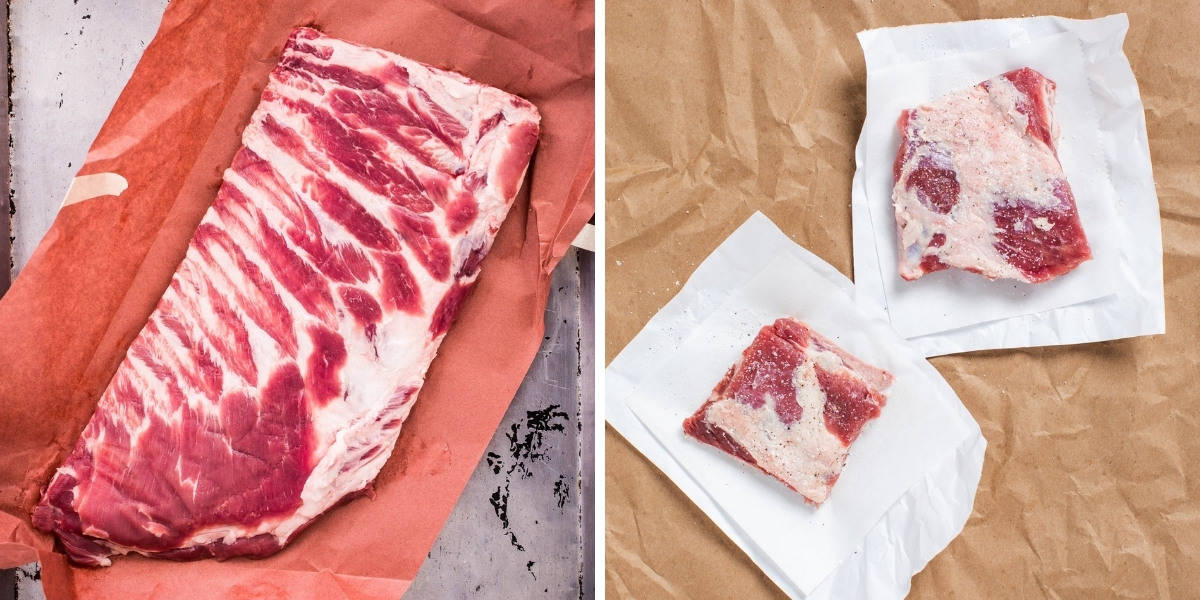
Porter roads spare ribs are all-natural, hormone and antibiotic-free, coming from pigs that live out in and explore the woods, giving a rich deep red meat that is full of flavor. Very meaty and well-marbled, each rack weighs between 2 and 3 pounds.
Their pork short ribs are actually a cut I've not come across anywhere else! Porter Road describes them as a cut that: "combines the perfect ratio of fat and meat….(they) start tough, and are ideal for smoking or braising in the crockpot. Settle in for a few hours of cooking, the payoff for your patience will be outstanding."
Sounds great to me!
Check Price at Porter Road
Beef Rib Cuts
Since you can't very well plate an entire beef rib from stem to sternum, beef ribs are divided into three separate cuts. Some butchers subdivide them even further, but these are the most common different types of beef ribs.
Let's meet them, shall we?
Plate Short Ribs
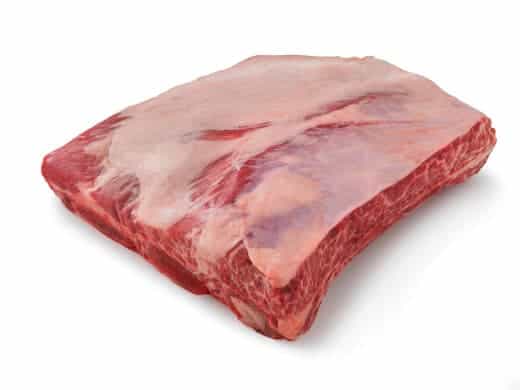
Also called "beef short ribs," these are massive, throw 'em over your shoulder, release your inner cave person ribs that make drool-worthy pics for the web.
Plate short ribs come from the lower section of the rib cage, and they're incredibly tender and loaded with meat.
Chuck Short Ribs
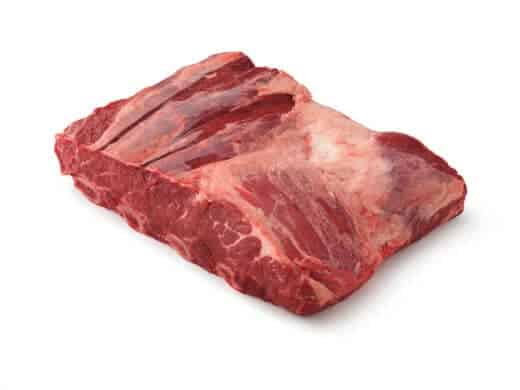
Less gargantuan than the plate short ribs, but still impressive, these ribs come from a little higher up towards the back of the cow. The bones are smaller, but there's still a lot of meat to be had.
Chuck short ribs are a lot easier to find at the grocery store, too.
Beef Back Ribs
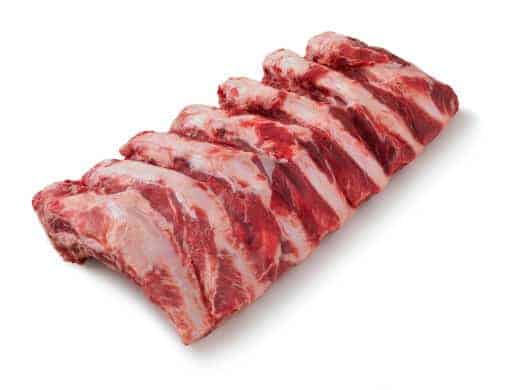
Found right up at the top of the back, beef back ribs look nothing like the short ribs. The meat is excellent — no surprise, since it's basically what you get on a prime rib roast.
You don't get the stack of meat on top of the bone like you do with shorts. Instead, all the yummy beef is sandwiched between the bones.
Where to Buy Beef Ribs Online
A number of online outlets sell beef ribs, making variety and price range highly variable! Here are two of the most popular suppliers:
Porter Road
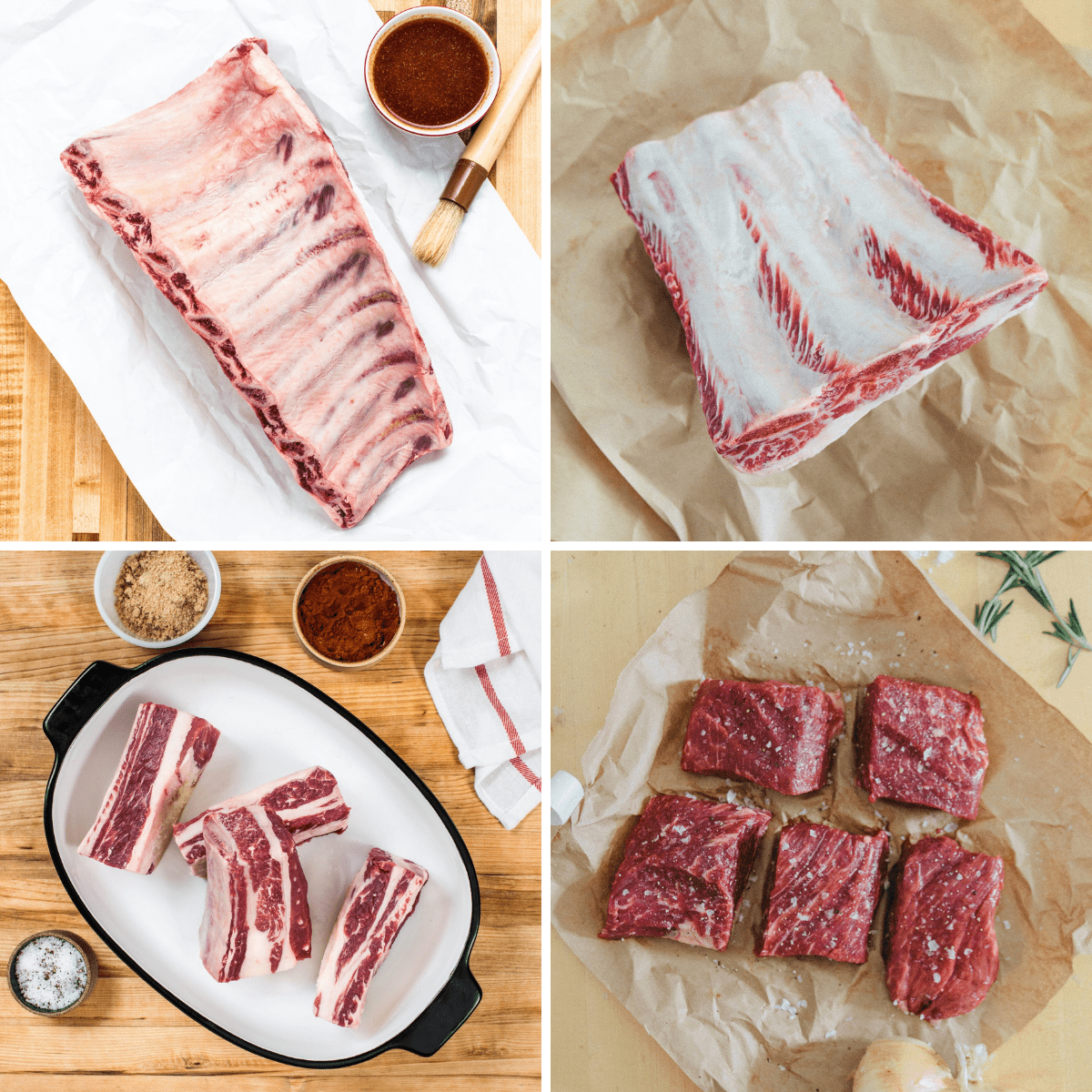
Porter road have a selection of four different beef rib cuts available that are all pasture-raised and hormone and antibiotics free:
- Beef back ribs, shipped frozen, weighing between 2 and 3 lbs per rack. These ribs are cut from a whole ribeye section, leaving a generous amount of rich marbled meat.
- Dino ribs, shipped frozen, weighing between 5 and 7 lbs per rack. Cut from the first 3 ribs of the rib plate, these 8"+ ribs are dry-aged for maximum flavor and are the giant ribs you see in Instagram pics that are sure to impress your guests!
- Texas short ribs, shipped frozen, 4 per pack weighing a combined 2.75 to 3.25 lbs. These individually cut portions smoke and eat well with their balanced mix of meat and fat.
- Boneless short ribs, 5 per pack weighing a combined 2.4 to 2.7 lbs. Though still generously marbled and packed with flavor, these are the leanest of their beef ribs on offer.
Check Price on Porter Road
Snake River Farms
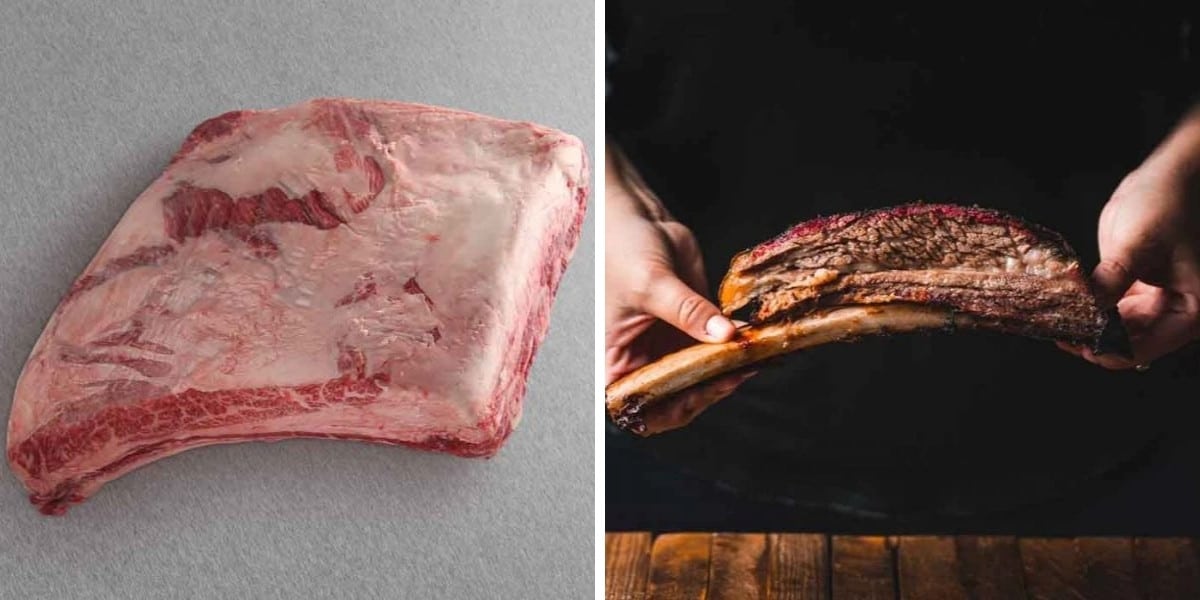
Snake River Farms short ribs are American Wagyu Black grade, which means they have a higher marbling than even USDA prime, which provides a beefy umami richness and depth of flavor that has to be tasted to be believed.
Each rack weighs in at an average 6 lb, so they are large and have that instagrammable 'dino rib' appearance.
Check Price on Snake River Farms
Fat to Meat Ratio and Fat Content
Want to know what you're getting on your rack? Let's assess the contents of each type.
Remember: these are generalizations — meat and fat content varies from breed to breed and animal to animal, and will also change depending on how the butcher cuts the racks.
Pork Ribs
It varies from cut to cut, but generally speaking, pork ribs are reasonably lean, at least when compared to beef ribs.
The lower on the rib cage you go, the more the meat-to-fat ratio slides over to the fatty side, and the rib tips are mostly fat. The amount of bone is fairly consistent across the three major cuts (baby back, spare, St. Louis style).
Overall, if you're doing a side-by-side with beef, pork ribs are lean and moderately meaty with more meat than fat and a lot of bone.
Beef Ribs
Despite a pig's reputation for being a chunky animal, there is a lot more fat in beef ribs than in pork. But, that's ok; we eat them for the flavor, not for the health benefits!
There is also an enormous amount of meat on beef ribs, but it's heavily marbled. The bones are huge, but you often get a walloping stack of beef piled on top of each rib.
To summarize, beef ribs are fattier than pork ribs, with closer to even portions of meat and fat. But, while the bones are larger individually, there is proportionately more meat per bone than on pork ribs.
Pork Ribs (Spare Ribs) Nutritional Info Per 4oz (¼ Pound)
| Nutrition | Total Amount | % Daily Value (based on 2000 calories/day) |
|---|---|---|
| Calories | 230 | |
| Total Fat | 16 g | 25% |
| Cholesterol | 70 mg | 23% |
| Sodium | 90 mg | 4% |
| Protein | 17 g | |
| Calcium | 0% | |
| Iron | 4% |
Beef Ribs (Short Ribs) Nutritional Info Per 4oz (¼ Pound)
| Nutrition | Total Amount | % Daily Value (based on 2000 calories/day) |
|---|---|---|
| Calories | 345 | |
| Total Fat | 25 g | 39% |
| Cholesterol | 113 mg | 38% |
| Sodium | 80 mg | 3% |
| Protein | 29 g | |
| Calcium | 1.0% | |
| Iron | 17% |
Price Comparison
Got a budget for your ribs in mind? Let's compare the average costs and see which best suits your current bank statement. Of course, prices will fluctuate based on location and quality, but these averages are reasonable starting points. (All prices are in United States dollars.)
Pork ribs are, on average, less expensive than beef ribs. What you pay will vary depending on the cut and where it's from; your typical grocery store rack will be considerably less expensive than one sourced from, say, a local organic farm.
At the time of writing, baby back ribs average around $4.50/lb or about $9.90/kg. Thanks, to lower demand, spare ribs are closer to $3.00/lb or $6.60/kg.
For beef ribs, expect to shell out a bit more. While back ribs are similarly priced (averaging $4.50/lb or $9.90/kg), the coveted short ribs are in the neighborhood of $7.00/lb or $15.40/kg.
How to Cook Pork Ribs
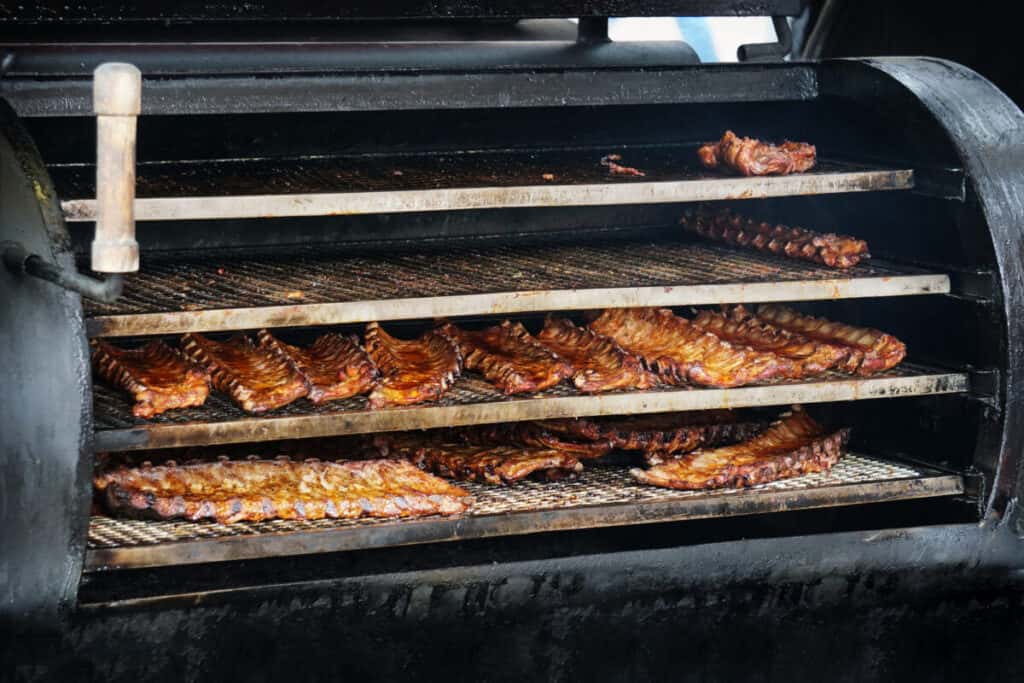
Pork ribs can be cooked in or on almost anything. But, why would you not choose to smoke them when that's an option? Here's a basic breakdown of how to cook pork ribs in a smoker.
First, you'll want to prep your ribs. This will vary from not much of anything, to major excising of unwanted flaps of meat and fat. You'll almost certainly need to take the time to remove the membrane before cooking.
Once the membrane is gone, now you can apply your brine or marinade, and then massage in your spice rub. Then it's time for the smoker.
How long you smoke them for and what temperature varies in specifics by cut, recipe, and preference. A typical pork rib smoke session will last 5 or 6 hours, with an average temperature of 225 to 250 °F.
Your wood choices are plentiful and will depend on your preference. Rib experts most frequently choose mesquite or hickory for full-bodied smoke flavor, or apple, cherry, or maple for lighter smoke with fruity notes.
Not everyone does it, but we think wrapping your ribs in foil part-way through a smoke session is an essential part of the process. It's a surefire way to turn out moist and tender ribs with flavor in every bite.
How long does it take to grill ribs? 6 hours or less. Beginners and pitmasters alike generally default to the tried-and-true 3-2-1 method for smoking pork ribs.
It's easy to follow: 3 hours naked in the smoke (the ribs, not you), 2 hours wrapped in foil with fluid in the smoke, and 1 hour unwrapped in the smoke but at a slightly higher temperature. This system takes a lot of the guesswork out of smoking ribs.
There are variations on the 3-2-1 method, chiefly the 2-1-1 (not "da doo ron ron" — which you're now singing) and 2-1-0.5. These shorter times are ideal for smaller racks, or for less crispy and chewy bark.
If you like sauce on your ribs, and many of us do, paint it on during the final half hour. If you put it on earlier, it's going to burn and taste awful.
As with all cooked meat, it's ready when thermometer says it's ready, but also when it "feels" done. Pork is technically "safe" at 145 °F, but the ribs won't be at peak tenderness and texture until they're in the 190 °F–200 °F range, but also when they feel like a hot knife through butter when you prick them with a skewer.
How to Cook Beef Ribs
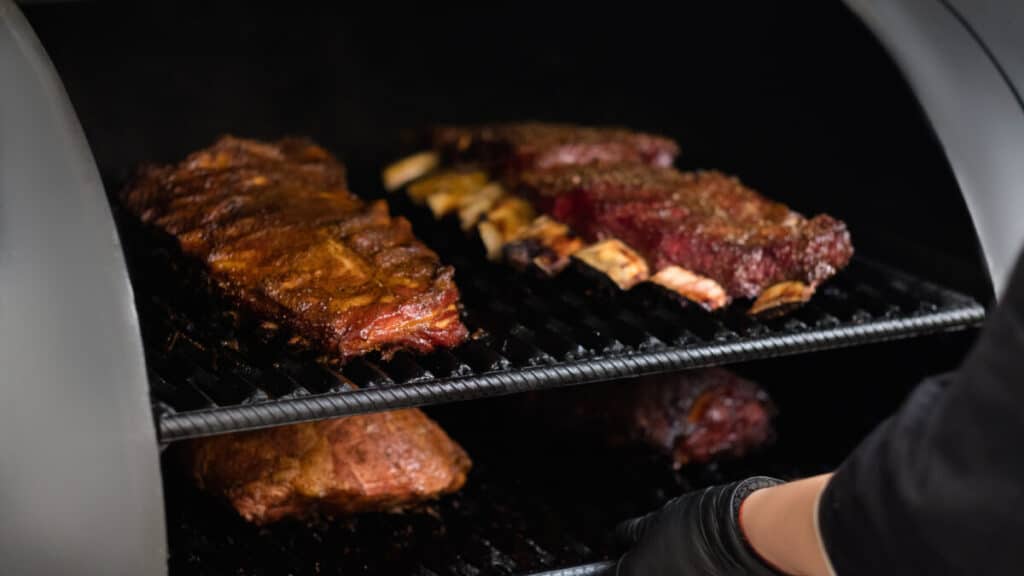
Feel like smoking some big, bold beef ribs? You could check out my full recipe on smoked beef ribs. But also, here's a general guide to getting the best results from beef ribs out of your smoker.
Most beef rib racks will not need any trimming ahead of smoking. If you've read the section on cooking pork ribs already, and you know about the membrane, you probably think it needs to come off the beef ribs, too. Not the case! You can leave it right where it is to ensure the meat stays attached to the bones. (If it really offends you, though, go ahead and peel it off.)
Keep your seasonings to a minimum; beef ribs have a ton of natural flavor, and you want to bring it out, not cover it up. Stick with salt and pepper, and you'll be fine. You can mix it up if you want with some garlic salt, or maybe some chili, but don't go crazy with the spices like you might on pork ribs.
Set your smoker to between 225 – 250 °F for a traditional low n slow. Though you can crank it up to between 275 – 300 °F; beef ribs are hefty and can take the extra heat. In fact, you'll need it if you want them ready to eat in a manageable time frame. You can cook them lower if you want, but you could be waiting a few extra hours to eat, depending on the size of the rack.
What wood should you use? As with pork ribs, mesquite and hickory are classic go-to's. Pecan is also great with beef, as are oak and cherry for rich, lush flavor. Don't bother with lightweights like maple or alder — they'll be lost when mingled with beef's strong flavor.
As with pork ribs, you can employ the Texas crutch where you wrap the ribs for part of the cook, like in the 3-2-1 method described above. However, with beef ribs being so much larger, they take longer to cook. I personally go for 4 to 5 hours smoking unwrapped, then the remainder of the cook wrapped in pink butcher paper or foil.
Whether to wrap your beef ribs or not, is perhaps even more controversial than it is with pork. Some genuine experts swear it just creates mushy meat. Others, who are just as expert, appreciate the tenderness wrapping brings and the reduced cooking time. Some pitmasters compromise and use pink butcher paper. Butcher paper breathes, so the humidity in the envelope is lower.
We're partial to wrapping beef, but we'll leave the final decision up to you. Actually, your best bet is to try it both ways and see which you prefer. It's about making you happy, not us!
Just like with pork ribs, you should continue to cook beef ribs way past the USDA safe temperature of 145 °F until you reach at least 190 °F. The higher temperature will render the fat and collagen, further tenderizing your meat.
3 Excellent Pork Rib Recipes from Around the Web
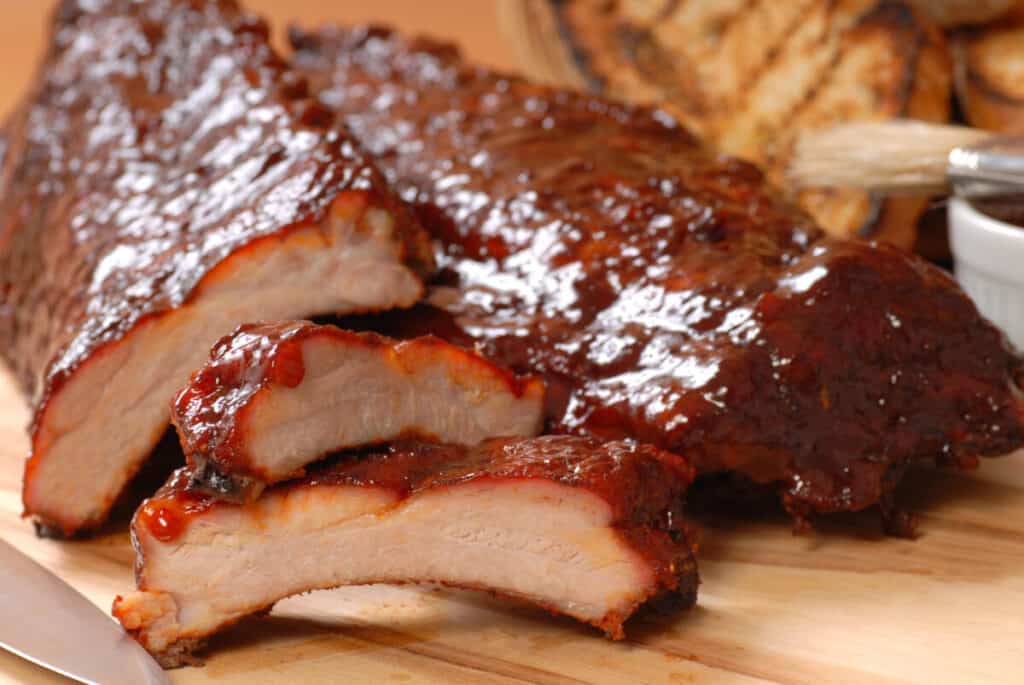
There is an insane number of pork rib recipes on the internet. Lucky for you, we've pulled 3 of the best for your smoking pleasure.
Smoked Dr. Pepper Ribs
Pork ribs are well suited to sweet sauces. And what's sweeter than Dr. Pepper? And, since the soda has a bit of a spicy bite to it, it's a perfect pairing with the other ingredients, including cayenne pepper. If you like getting hands-on with your cooking, you'll enjoy creating the custom sweet BBQ rub and Kansas City style BBQ sauce that go along with the recipe.
This recipe calls for tender baby back ribs and will feed up to 6 people. You can adjust the spice level to suit your crowd, but you should overall expect sweet and sticky ribs with a bit of a zing — just enough to make your tongue tingle.
Are you a Pepper? Then check out this Dr Pepper ribs recipe.
Competition Style Smoked Pork Ribs
Even if you never smoke competitively, you can live vicariously through this recipe. It uses the 3-2-1 method detailed earlier, so it's practically foolproof. (There are no guarantees in barbecue!) You'll get to make your own dry rub and red wine-based BBQ sauce, and you'll need a spray bottle full of apple cider vinegar as a spritz for ribs.
The flavor profile will be sweet, but lush and juicy and mildly smoky thanks to the gentle nature of cherry. They also look gorgeous, with a deep mahogany color, again, partially thanks to cherry wood. Not only are they crowd-pleasers, but they're also crowd-impressors.
Ready to show your competitive nature? Click here for the competition ribs recipe.
Indian-Spiced Ribs
Remember earlier when I said pork ribs are a blank canvas? This recipe for St. Louis style ribs paints them thick and colorfully! An otherwise traditional rub gets an exotic twist with turmeric and garam masala, both classic Indian spices. You'll also create a tamarind chutney for dipping. It has a bit of spice, but overall it's a sweet counterpart to the heavily seasoned ribs.
Arm yourself with oak or pecan for smoke — no fruit woods here! You'll come away with 4 servings of ribs like you've never had before. Anyone with a passion for international cuisine will love both the incredible aroma and the exciting taste of these ribs.
Click this way to go on to the Indian spiced pork ribs recipe.
3 Excellent Beef Rib Recipes from Around the Web
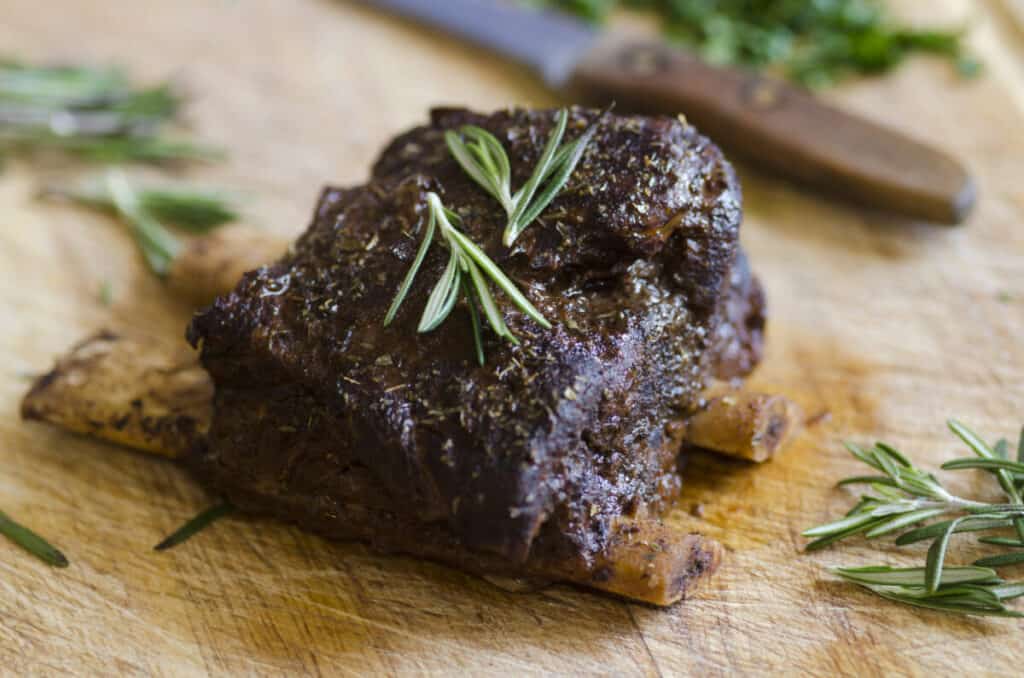
We've got no beef with beef ribs! Here are some mouth-watering recipes to get you started.
Smoked Cola Coffee Beef Ribs
Hello there, tall, dark, and delicious! We couldn't help but include this recipe, with its inventive cola-coffee barbecue sauce. Even the dry rub contains ground coffee beans, along with a bit of spice. Expect boldly smoky flavors, too — the recommended woods are oak, mesquite, or hickory.
The overall experience will be intensely flavorful and not for the faint of heart. It isn't spicy, but it is incredibly rich. This recipe uses 2 racks of beef back ribs, so there will be enough meat to feed a small crowd. Or, just a few ridiculously hungry people.
Feeling extra bold today? Then check out this cola coffee rib recipe.
Texas-Style Beef Short Ribs
Everything is bigger in Texas, don't you know. That includes the ribs. This deceptively simple recipe allows you to try authentic Lone Star State cuisine in your own yard. There's really not much more to it than salt and pepper, a moderate amount of smoke, and time.
What you'll need that you may not already have is butcher paper. Instead of wrapping in foil, these honking ribs are going to spend some time in the paper to get nice and tender. While it may not seem like much of a recipe, it's ideal for letting the savory taste of the beef shine. We love pork ribs, but you'd never try such a minimalist approach to the pig.
For a taste of Texas, say "yee-haw" and click here for this Texas-style rib recipe.
Dinosaur Ribs (Pineapple-Marinated Smoked Beef Ribs)
It's time to get prehistoric with your smoker! Ok, so they're not real dino bones. They're not even from a frozen mammoth. They are, however, huge. And very, very, tasty. But, you'll need to set aside a lot of time for this one, including a few minutes to whip up the pineapple juice and Worcestershire sauce marinade on the stovetop or side burner.
Despite the pineapple, this won't be especially fruity, though it will be tangy. Match it with your favorite sweet and smoky barbecue sauce for dipping, and you've got a guaranteed summer BBQ hit on your hands. This recipe does not follow the 3-2-1 method, but since it's from none other than Steven Raichlen, we're pretty confident it's going to work out.
Get all the juicy details at the other end of this link: Dinosaur smoked rib recipe.
Final Thoughts
Now that you're up to speed on both pork and beef ribs, which will you tackle next in your smoker? Of course, there's no wrong answer to that question. Either way, it'll be another exciting step on the road to mastering the grill in all its forms.
Thanks for trusting us to answer your questions about outdoor cooking. If you like what you read here, please share it with your barbecue brethren. And, come join us on social to connect with other BBQ fans and see what's new at our site.
Here's to being the best griller you can be.
Source: https://www.foodfirefriends.com/beef-ribs-vs-pork-ribs/
0 Response to "Is Beef Ribs Good for You"
Post a Comment